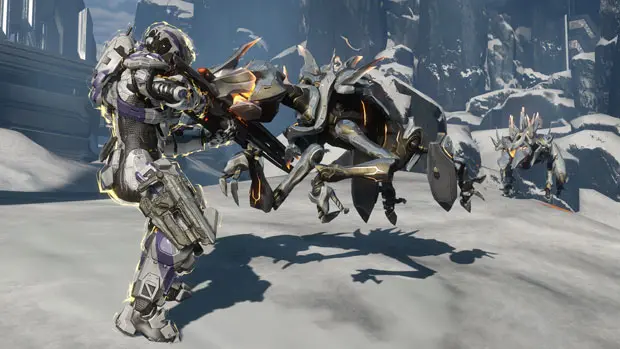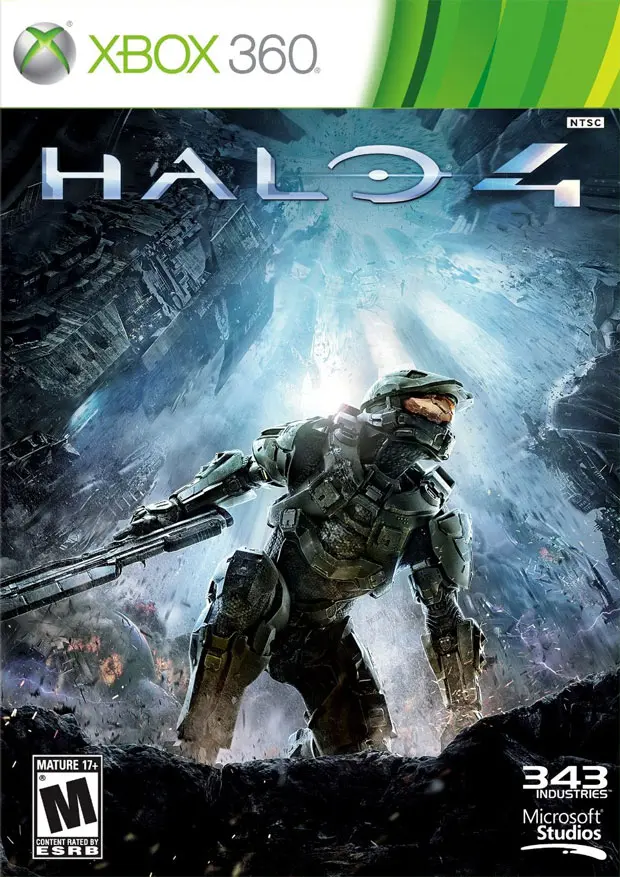 Halo 4 is a triumph.
Halo 4 is a triumph.
Those aren’t words easily written considering Microsoft’s flagship Xbox 360 franchise has been passed from its founding fathers at Bungie to 343 Industries. Yet despite new blood turning the creative wheel, at the core Halo 4 is the same Halo we know and love starring Master Chief and Cortana, only now fine-tuned and polished in some expected and unexpected ways.
Master Chief finally returns to save the universe after being freshly thawed from his four year, seven month and ten day nap aboard Forward Unto Dawn. Since Chief has been down for so long, so has Cortana, and unfortunately for A.I. constructs, this means Cortana’s expected shelf life has come and gone. She is slowly slipping into “rampancy” that will literally cause her to “think herself to death,” as she bluntly explains the dire predicament to a non-accepting Chief.
Halo 4 fundamentally shifts at this unfortunate news. Yes, there’s a new enemy lurking in the shadows that can spell doom for mankind, and Master Chief is tasked with becoming humanity’s savoir – again. But for the first time in the Halo mythos, Cortana’s fate and her relationship with John becomes the focal point as both damaged characters struggle to understand their place amongst humanity and the people they risk their lives for.
I began to develop plausible theories about how John and Cortana’s arc would ultimately conclude as each chapter progressed and cut-scenes were unveiled. This kind of deep emotional storytelling is a strong part of what has always set the Halo games apart from the pack, and Halo 4 raises the bar to new heights by pushing Cortana’s wonderfully told story to the forefront.

Those cut-scenes are bar none the best that have ever graced a Halo game. The opening cinematic feels like a movie unto itself, and each successive segue from combat into the story is like opening up a new Christmas gift. The animation, explosive and enveloping sound, rendering, voice acting, lighting; no expense has been spared to make the Halo 4 story presentation befitting of Xbox’s jewel in its crown.
Observant players might pick up on the Halo “monk chant” theme making a brief cameo in newcomer Neil Davidge’s emotionally driven score. The story benefits from Davidge’s music that takes on a cinematic feel. It’s not as memorable as the chords struck by Bungie’s Marty O’Donnell such as those chants, but appropriately services the story as it tonally shifts from chapter to chapter.
As previous Halo games have taught us, not all is quite clear and easy to understand in this complex universe. There are some key questions left unanswered and some answers don’t make a whole lot of sense. I suspect re-watching the cut-scenes will offer some additional clarity. Select story elements seem designed to leave a trail into the next two or more games. Others quite pertinent to the backstory are buried within Terminals that unfortunately cannot be viewed without exiting the game and visiting Halo Waypoint. In other words, don’t skip locating those Terminals.
343 Industries wisely did not attempt to reinvent the gameplay wheel when handed the keys to Halo 4. There are no grand innovations or radical changes to the proven formula. Instead there are some subtle and not-so-subtle new additions that complement and build upon what’s come before.

It was clever of 343 to begin Halo 4 by having Chief fight his way out of Forward Unto Dawn against Covenant forces. It hearkens back to the first chapter of Halo, though comparing the two would be apples to oranges. The mechanics are the same, but the evolution in design and environmental diversity has come a long way.
Mixing up combat terrain is one area where 343 have zeroed in on. Requisite environments like UNSC ships, Covenant structures, and open terrain have all been passed down. The introduction of the Forerunners provides a new style of architecture, and their planet that Forward Unto Dawn crashes on, Requiem, has some amazing topography ranging from forests to desert canyons that Master Chief must traverse. These are gargantuan areas by Halo standards that open up the game’s levels to feel more sandbox and less a forced singular path.
Halo 4 wouldn’t fit in with its predecessors without some redundancy. Switch activation is a common theme, and more often than not, each connected switch is in an identical or mirror-image area of the others. It gets mildly frustrating to activate the first switch then realize the next switch will be an almost identical fight. Halo veterans are used to this kind of redundancy and have learned to accept it.
If you take away the new Promethean enemies, Halo 4 plays virtually identical to past games. The pacing is similar with vehicular levels mixed in (one is new to the franchise, but I won’t spoil it), the “quiet” areas with up or down ramps between combat rooms, the weapon stashes that telegraph if the next area will be long-range or close-quarters combat; it’s all strikingly familiar. And that’s a blessing as the gunplay in Halo games has always been its strength, so to tinker with that and jeopardize it would have been a foolish endeavor.

The devilish looking Prometheans add a fresh new element that requires a different approach. Flying Watchers are destined to become one of the most hated Halo enemies yet. Not only can they be tricky to shoot down, but they also can revive and place temporary shields around the Knights. Crawlers require a head shot to take down, are usually found in packs, and can run up walls. And the two types of Knights can teleport and become especially tricky on the harder difficulties. These thinking enemies are the antithesis of the mindless Flood. The higher the difficulty level is set, the more apparent their cunning A.I. becomes.
The Promethean weapons are unfortunately a small letdown in comparison to the beasts wielding them. Animations that “assemble” them are neat to watch the first couple times, but it takes a couple seconds to complete, and enemies don’t take a smoke break while the animation cycles through. The Promethean weapons also mirror the Covenant weapons a little too closely. These are the fabled Forerunners, after all, so I was surprised to see them with machine guns, shotguns and sniper rifles with flashy new skins. Something a little more exotic and unfamiliar would have been more fitting.
I must call out a pair of comical bugs that popped up while playing through the campaign. The first occurred while trying to flip a Scorpion tank upright. In mid-flip, Master Chief teleported 200 feet in the air and hovered above Requiem. I could walk him high in the sky but couldn’t get him down. The second bug allowed a Promethean Knight to get stuck in a small structure so that his gun was sticking out and nothing else. Not quite as exciting as the first, but still worth a chuckle.
Halo 4 carries forward all the multiplayer goodies competitive players have grown to love and are accustomed to finding. Matchmaking and customization, as well as Forge and Theater, are all present and accounted for, performing virtually identical to their past counterparts.
At launch, Halo 4 includes thirteen total multiplayer maps, three of which are Forge-created. There is a little something for everyone spread out amongst them, including a Grifball Court variant of Erosion that seems more fun than anything else. I don’t believe any map necessarily jumps out as a clear winner at this point, but it is still a bit too early to tell.

Truly new is Spartan Ops, a concept that is not wholly original but will potentially open up the world of Halo multiplayer to a broader gamut of players. Spartan Ops is a self-contained story that runs parallel to Halo 4 complete with its own extensive cut-scenes that require an install off a second disc. It will consist of ten total episodes with each containing five parts. Episode 1 is available now and additional episodes will be released on a weekly basis going forward. Best of all, you already paid for every episode of Spartan Ops when plunking down cash for the game.
Spartan Ops offers solo or cooperative challenges that must be completed on the difficulty level of the player’s choice. Obviously the more players that join in, the easier the challenges will be to complete. It’s straightforward and doesn’t add much replay value once the episode is complete for seasoned gamers that tackle it on Legendary right off the bat.
What will make Spartan Ops a hit outside the core gamer community isn’t the story or new challenges to undertake. It offers the ability for players to fight cooperatively, outside the campaign, and earn the same XP and perks as if they were fighting competitively. Think about that; all the gamers out there with no interest in fighting against other human opponents in fear of getting slaughtered or hearing nonsense over their headset can basically raise their rank and perks in little snippets that play like the campaign.

It has been a long wait for Master Chief and Cortana to return and I must admit, it’s been worth every holiday season without their presence. Shed any fear or doubt that 343 Industries taking on the burden of carrying forward Xbox’s greatest franchise would somehow be boggled. Halo 4 is the sequel Halo 3 should have been, and a righting of the ship after detours into Reach and ODST lost track of what we have been clamoring for the most.
Welcome back, Chief and Cortana. Now I sincerely cannot wait for Halo 5 to help usher in a new generation of Xbox console games.
– Dan Bradley
Shop for Halo 4 on Xbox 360 for a discounted price at Amazon.com (November 6, 2012 release date).



